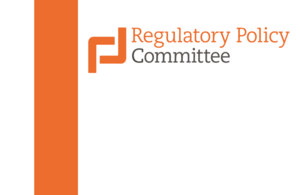RPC Launches New Opinion Templates
New RPC Opinion Template Launched

The Regulatory Policy Committee’s (RPC) key role is to provide independent scrutiny of the assessments which departments and regulators prepare when proposing new regulatory measures. These include impact assessments (IAs), post-implementation reviews (PIRs) and business impact target (BIT) assessments. Our review and opinions on the quality of evidence and analysis supporting new regulatory proposals are an important part of the policymaking process. In our opinions, we comment only on how effectively the relevant department or regulatory has assessed the policy’s potential impacts, not on the merits of the policy itself.
To help improve the clarity and transparency of our views, we are launching new templates for our opinions. We believe the updated format for our opinions will help ensure that policymakers, Parliamentarians and other stakeholders can readily understand the key messages in our opinions. In the new format, we set out our key messages up front in a more “bitesize” way, while still providing detail in the body of the opinion for those that want it.
RPC formal ratings
In many cases, we formally rate IAs (and other submissions such as PIRs) as “fit for purpose/not fit for purpose” on specific areas set out in the Better Regulation Framework (BRF) and the Business Impact Target: Statutory Guidance. For example, in our opinions on final stage IAs, we give formal ratings for two areas: the equivalent annual net direct cost to business (EANDCB) and the small and micro business impact assessment (SaMBA).
For the areas on which the RPC provides a formal rating we use the following ratings (based on the criteria indicated):
| Rating | Criteria |
| Green (“fit for purpose”) | The IA (or other submission) is fit for purpose. The RPC has no significant concerns over the quality of the IA, or there are some minor issues that could be improved. There may be many points for improvement, which the department should consider. |
|---|---|
| Red (“fit for purpose”) | The IA (or other submission) is not fit for purpose. The RPC has major concerns over the quality of the evidence and analysis, and the overall quality of the IA (or other submission), that need to be addressed. |
New RPC quality indicators
In addition, in our opinions, we often comment on the quality and robustness of the evidence and analysis in other areas, on which we do not provide a formal rating. We note, in such cases, where the analysis is of particularly high quality, and areas where we consider improvements are needed.
In the interests of increased clarity and transparency, we have introduced “quality indicators” in our opinion summaries, covering key areas, which we consider in our opinions, but which are not formally rated. For IAs these areas include the quality of analysis and evidence supporting the ‘rationale and options’, ‘cost-benefit analysis’, ‘wider impacts’ and ‘monitoring and evaluation’ (and similar areas in other types of submissions).
We use the following quality indicators:
| Quality indicator | Criteria |
| Good | Addresses the issue well. The analysis is sufficiently robust and addresses the issue properly. The analysis is based on good to high-quality, proportionate evidence and uses appropriate assumptions. It could be improved only in minor areas (if at all) and provides good support for decision-making on these aspects of the assessment. |
|---|---|
| Satisfactory | Addresses the issue adequately. The analysis is considered satisfactory. The analysis is based on adequate, proportionate evidence and uses appropriate assumptions. Some improvements could be made, but it provides sufficient support for decision-making on these aspects of the assessment. |
| Weak | Weak analysis of the issue. The analysis is not sufficiently robust to address the issue. Improvements are required in one or a number of areas. It provides inadequate support for decision-making on these aspects of the assessment. |
| Very weak | Very weak analysis of the issue. The analysis is poor and has significant flaws. Significant improvements are required in one or a number of areas. It provides inadequate support decision-making on these aspects of the assessment. |
We believe that the new opinion templates will help us to convey our key messages in a clearer and more consistent way. We hope that our key messages will stand out more clearly in the new format, so that all stakeholders can easily see our key findings, without sacrificing the detail where it is needed to explain our views.
We are intending to review how this new approach is working in around six months. In the meantime, we are always keen to hear from our stakeholders. If you have any comments, please pass them on to your regular contacts in the Secretariat or email regulatoryenquiries@rpc.gov.uk.